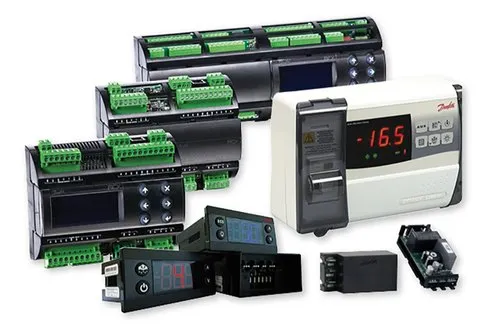ERC / EKC Electronic Refrigeration Controls
ERC and EKC electronic controls are designed to manage energy consuming functions in commercial refrigerators. Depending on the type of controls, functions are also available for regulating defrosting and fan operation.
Models:
1. ERC 101
2. ERC 111
3. ERC 112
4. ERC 211
5. ERC 213
6. EKC 102
EKC Water Chiller Controls for electronically operated valves
Water cooler controls, with superheat control, thermostat function, for control of AKV valves or step motor valves, and with optional use with air coolers, e.g. freezer stores.
Model:
1. EKC 312
EKC 312 is a controller for operation of evaporators in water chillers. The controller and valve can be used where there are requirements for accurate control of superheat and temperature in connection with refrigeration,
- Processing plants (water chillers).
- Cold stores (air coolers)
- AC Plants
EKC 312 controls the superheat in the evaporator by a pressure transmitter, Type AKS 33, and a temperature sensor
(Pt 1000 ohm). The expansion valve is with step motor of the type ETS.
EKC Media temperature controls
Temperature regulation with evaporating pressure control.
Used when there are stringent requirements to accurate temperature control.
Model :
1. EKC 361
The controller and valve can be used where there are stringent requirements to accurate temperature control in connection with refrigeration, e.g.:
- Cold room for fruits and food products.
- Refrigerating systems.
- Work premises in the food industry.
- Process cooling of liquids.
Temperature sensor = Type AKS (Pt 1000 ohm).
Liquid Level Controls
Controls for level regulation of refrigerant.
Model:
1. EKC 347
EKC 347 liquid level controller is used for regulation of the refrigerant level in:
- Pump reservoirs.
- Separators
- Intermediate coolers
- Economisers
- Condensers
- Receivers
- Liquid level control
- Alarm if the set alarm limits are exceeded
- Relay outputs for upper and lower level limits and for alarm level
Analog input signal which can displace the reference
